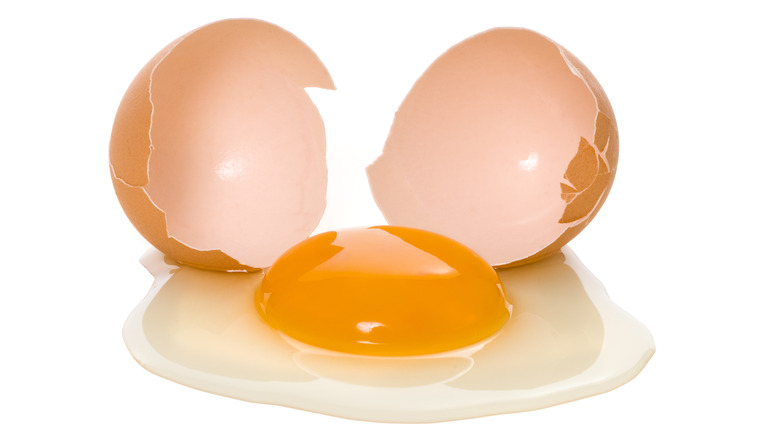What Is A Meat Spot On An Egg And Is It Safe To Eat?
When you crack open an egg to make your morning omelet, you may occasionally notice some strange discolored spots in the whites of the egg. You may choose to remove them to make the egg a little more visually appealing, but should their presence be any cause for concern?
Fortunately, these discolored flecks are totally harmless and safe to eat. They're called "meat spots," and they are actually protein deposits. These spots can take on a brown or off-white hue, standing out against the usually clear-colored egg white.
The presence of meat spots in the egg whites may even mean that the eggs are fresh from the farm. The color of the spots fades as they are given more time to reabsorb into the eggs. So if they're present and still visibly brown when you crack your egg open, it's likely that the eggs have been more freshly laid.
You may not see the spots in store-bought eggs
Some have theorized that these meat spots could mean the eggs contain a chicken embryo. However, eggs sold in grocery stores have not been fertilized, so there's no correlation between the two. Additionally, you're more likely to find meat spots in brown eggs, most often found in the Northeast region. A study published by the National Library of Medicine estimated that around 18% of brown eggs contain these spots. The spots were significantly less common in white eggs.
If you purchase your eggs directly from farms, they may also be more likely to contain these spots. Eggs sold in grocery stores go through candling, where a light shines through eggs to determine their quality. Any imperfect eggs — like those containing meat spots or those that are spotted or bumpy – are often deemed unsuitable for sale. This process removes a majority of eggs containing meat spots, although some may still slip through.
How do meat spots appear in eggs?
Egg whites develop meat spots when blood clots in the egg white as the egg forms. During this formation process, small pieces of tissue from the hen's ovary can attach to the egg. That tissue becomes the meat spot — a little extra protein in the egg.
The age of the chicken laying the eggs plays a factor in how common meat spots will be; the older the chicken, the more likely meat spots will be in the eggs. Additionally, environmental changes — like a decreased intake of vitamins, external stress, and even changes in lighting can cause these spots to appear more frequently.
If you crack open an egg and find a meat spot in the white, you can still prepare your dish as usual. The spot may cause discoloration when making egg-white-focused foods, like poached eggs. But if you don't mind a minor imperfection in the appearance, enjoy your eggs as-is.


